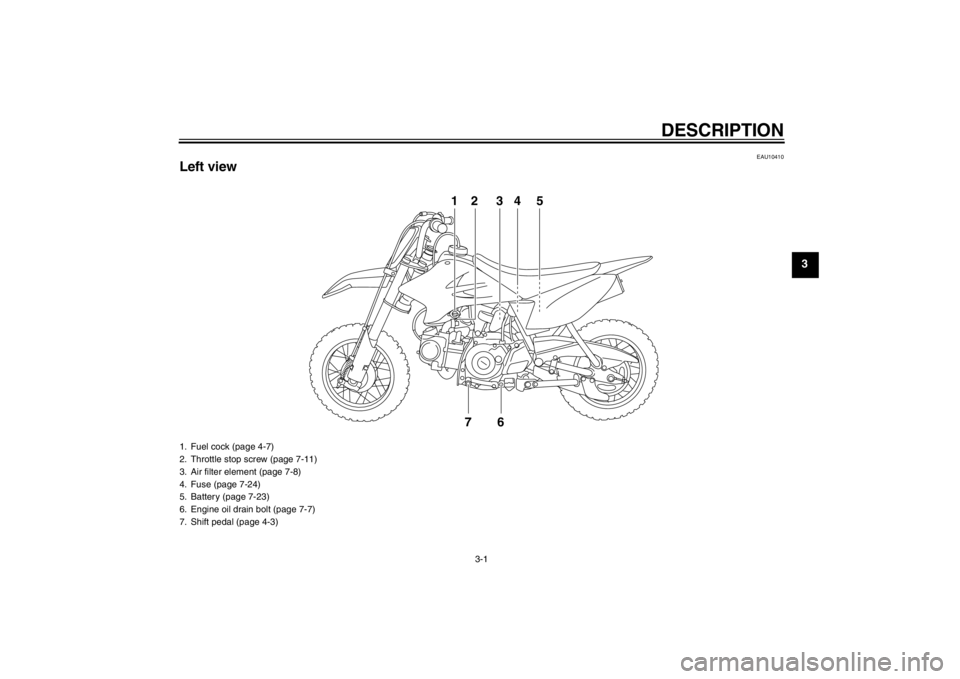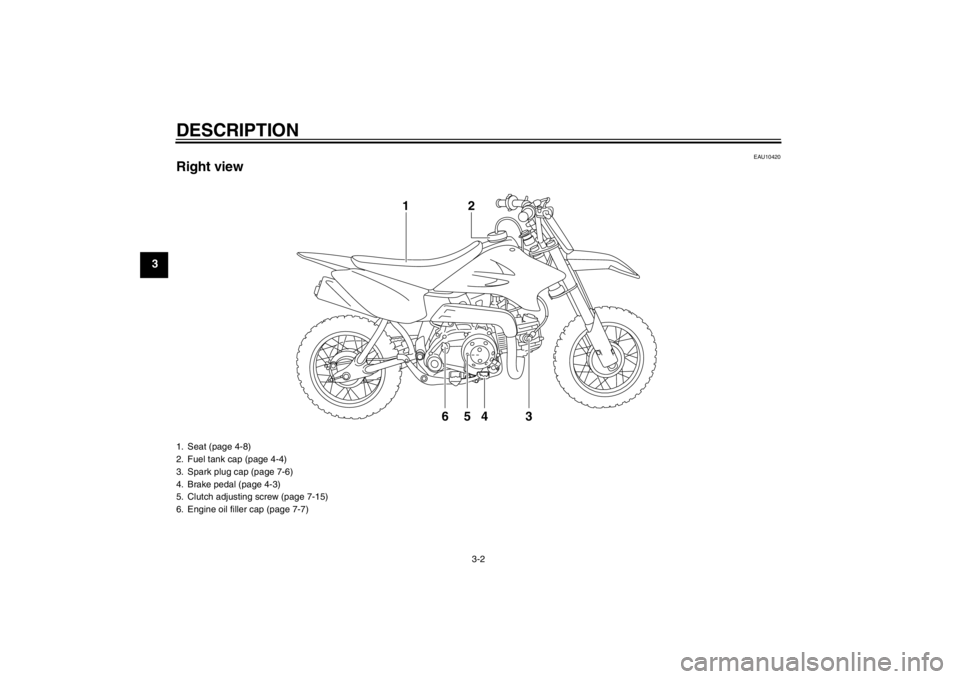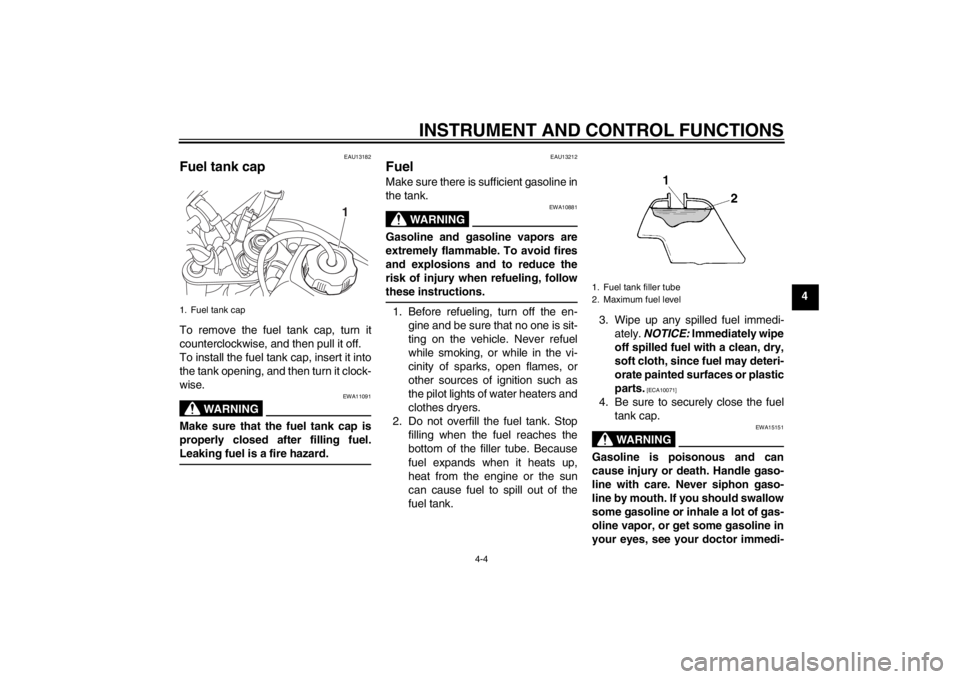engine YAMAHA TTR50 2013 Owners Manual
[x] Cancel search | Manufacturer: YAMAHA, Model Year: 2013, Model line: TTR50, Model: YAMAHA TTR50 2013Pages: 86, PDF Size: 1.8 MB
Page 9 of 86

TABLE OF CONTENTS
LOCATION OF IMPORTANT
LABELS ............................................1-1
SAFETY INFORMATION .................. 2-1
DESCRIPTION .................................. 3-1
Left view .......................................... 3-1
Right view ........................................ 3-2
Controls and instruments ................3-3
INSTRUMENT AND CONTROL
FUNCTIONS ....................................... 4-1
Main switch ..................................... 4-1
Handlebar switches ........................ 4-1
Speed limiter .................................. 4-2
Shift pedal ......................................4-3
Brake lever ..................................... 4-3
Brake pedal .................................... 4-3
Fuel tank cap .................................. 4-4
Fuel ................................................ 4-4
Fuel tank breather hose ................. 4-7
Fuel cock ........................................ 4-7
Starter (choke) lever ....................... 4-8
Seat ................................................ 4-8
Sidestand ....................................... 4-9
Starting circuit cut-off system ......... 4-9 FOR YOUR SAFETY –
PRE-OPERATION CHECKS
............. 5-1
OPERATION AND IMPORTANT
RIDING POINTS ................................ 6-1
Starting and warming up a cold engine ......................................... 6-1
Starting a warm engine .................. 6-2
Shifting ........................................... 6-2
Engine break-in .............................. 6-3
Parking ........................................... 6-4
PERIODIC MAINTENANCE AND
ADJUSTMENT ................................... 7-1
Periodic maintenance chart for the emission control system ............. 7-2
General maintenance and
lubrication chart .......................... 7-3
Checking the spark plug ................ 7-6
Engine oil ....................................... 7-7
Cleaning the air filter element ........ 7-8
Cleaning the spark arrester ......... 7-10
Adjusting the carburetor ............... 7-11
Adjusting the engine idling speed ........................................ 7-11
Checking the throttle grip free
play ........................................... 7-12
Valve clearance ........................... 7-12
Tires ............................................. 7-13
Spoke wheels .............................. 7-14
Adjusting the clutch free play ....... 7-15 Adjusting the brake lever free
play ........................................... 7-15
Adjusting the brake pedal free play ........................................... 7-16
Checking the shift pedal ............... 7-17
Checking the front and rear brake
shoes ........................................ 7-17
Drive chain slack .......................... 7-18
Cleaning and lubricating the drive
chain ......................................... 7-19
Checking and lubricating the
cables ....................................... 7-20
Checking and lubricating the throttle grip and cable ............... 7-20
Checking and lubricating the brake lever ................................ 7-20
Checking and lubricating the
brake pedal ............................... 7-21
Checking and lubricating the sidestand .................................. 7-21
Lubricating the swingarm pivots ... 7-21
Checking the front fork ................. 7-22
Checking the steering .................. 7-22
Checking the wheel bearings ....... 7-23
Battery .......................................... 7-23
Replacing the fuse ....................... 7-24
Supporting the motorcycle ........... 7-25
Front wheel .................................. 7-26
Rear wheel ................................... 7-28
Troubleshooting ........................... 7-29
Troubleshooting chart .................. 7-31
U2CJ80E0.book Page 1 Tuesday, June 12, 2012 11:15 AM
Page 21 of 86

SAFETY INFORMATION
2-2
2
●
Many accidents involve inexperi-
enced operators. Make sure that you are qualified and that you only lend your mo-
torcycle to other qualified opera-
tors.
Know your skills and limits. Staying within your limits may
help you to avoid an accident.
We recommend that you prac- tice riding your motorcycle until
you have become thoroughly fa-
miliar with the motorcycle and all
of its controls.
●
Many accidents have been caused
by error of the motorcycle opera-
tor. A typical error made by the op-
erator is veering wide on a turn
due to excessive speed or under-
cornering (insufficient lean angle
for the speed). Never travel faster
than warranted by conditions.
●
Ride cautiously in unfamiliar ar-
eas. You may encounter hidden
obstacles that could cause an ac-
cident.
●
The posture of the operator is im-
portant for proper control. The op-
erator should keep both hands on the handlebar and both feet on the
operator footrests during operation
to maintain control of the motorcy-
cle.
●
Never ride under the influence of
alcohol or other drugs.
●
Be sure the transmission is in neu-
tral before starting the engine.
Protective Apparel
The majority of fatalities from motorcy-
cle accidents are the result of head in-
juries. The use of a safety helmet is the
single most critical factor in the preven-
tion or reduction of head injuries.
●
Always wear an approved helmet.
●
Wear a face shield or goggles.
Wind in your unprotected eyes
could contribute to an impairment
of vision that could delay seeing a
hazard.
●
The use of a jacket, heavy boots,
trousers, gloves, etc., is effective in
preventing or reducing abrasions
or lacerations.
●
Never wear loose-fitting clothes,
otherwise they could catch on the
control levers, footrests, or wheels
and cause injury or an accident.
●
Always wear protective clothing
that covers your legs, ankles, and
feet. The engine or exhaust sys-
tem become very hot during or af-
ter operation and can cause burns.
Avoid Carbon Monoxide Poisoning
All engine exhaust contains carbon
monoxide, a deadly gas. Breathing car-
bon monoxide can cause headaches,
dizziness, drowsiness, nausea, confu-
sion, and eventually death.
Carbon Monoxide is a colorless, odor-
less, tasteless gas which may be
present even if you do not see or smell
any engine exhaust. Deadly levels of
carbon monoxide can collect rapidly
and you can quickly be overcome and
unable to save yourself. Also, deadly
levels of carbon monoxide can linger
for hours or days in enclosed or poorly
ventilated areas. If you experience any
symptoms of carbon monoxide poison-
ing, leave the area immediately, get
fresh air, and SEEK MEDICAL TREAT-
MENT.
U2CJ80E0.book Page 2 Tuesday, June 12, 2012 11:15 AM
Page 22 of 86

SAFETY INFORMATION
2-3
2
●
Do not run engine indoors. Even if
you try to ventilate engine exhaust
with fans or open windows and
doors, carbon monoxide can rap-
idly reach dangerous levels.
●
Do not run engine in poorly venti-
lated or partially enclosed areas
such as barns, garages, or car-
ports.
●
Do not run engine outdoors where
engine exhaust can be drawn into
a building through openings such
as windows and doors.
Loading
Adding accessories to your motorcycle
can adversely affect stability and han-
dling if the weight distribution of the mo-
torcycle is changed. To avoid the
possibility of an accident, use extreme
caution when adding accessories to
your motorcycle. Use extra care when
riding a motorcycle that has added ac-
cessories. Here are some general
guidelines to follow if adding accesso-
ries to your motorcycle:
Operation of an overloaded vehicle
could cause an accident.
●
The weight of the operator must
not exceed 40.0 kg (88 lb).
●
Accessory weight should be kept
as low and close to the motorcycle
as possible. Securely pack your
heaviest items as close to the cen-
ter of the vehicle as possible and
make sure to distribute the weight
as evenly as possible on both
sides of the motorcycle to mini-
mize imbalance or instability.
●
Shifting weights can create a sud-
den imbalance. Make sure that ac-
cessories are securely attached to
the motorcycle before riding.
Check accessory mounts fre-
quently. Properly adjust the suspension for your load (suspension-ad-
justable models only), and
check the condition and pres-
sure of your tires.
Never attach any large or heavy items to the handlebar, front
fork, or front fender. Genuine Yamaha Accessories
Choosing accessories for your vehicle
is an important decision. Genuine
Yamaha accessories, which are avail- able only from a Yamaha dealer, have
been designed, tested, and approved
by Yamaha for use on your vehicle.
Many companies with no connection to
Yamaha manufacture parts and acces- sories or offer other modifications for
Yamaha vehicles. Yamaha is not in a position to test the products that these
aftermarket companies produce.
Therefore, Yamaha can neither en-
dorse nor recommend the use of ac-
cessories not sold by Yamaha or
modifications not specifically recom-
mended by Yamaha, even if sold and
installed by a Yamaha dealer.
Aftermarket Parts, Accessories, and
Modifications
While you may find aftermarket prod-
ucts similar in design and quality to
genuine Yamaha accessories, recog-
nize that some aftermarket accessories
or modifications are not suitable be-
cause of potential safety hazards to you
or others. Installing aftermarket prod-
U2CJ80E0.book Page 3 Tuesday, June 12, 2012 11:15 AM
Page 23 of 86

SAFETY INFORMATION
2-4
2
ucts or having other modifications per-
formed to your vehicle that change any
of the vehicle’s design or operation
characteristics can put you and others
at greater risk of serious injury or death.
You are responsible for injuries related
to changes in the vehicle.
Keep the following guidelines in mind,
as well as those provided under “Load-
ing” when mounting accessories.
●
Never install accessories that
would impair the performance of
your motorcycle. Carefully inspect
the accessory before using it to
make sure that it does not in any
way reduce ground clearance or
cornering clearance, limit suspen-
sion travel, steering travel or con-
trol operation.
Accessories fitted to the handle- bar or the front fork area can
create instability due to improper
weight distribution. If accesso-
ries are added to the handlebar
or front fork area, they must be
as lightweight as possible and
should be kept to a minimum. Bulky or large accessories may
seriously affect the stability of
the motorcycle. Wind may at-
tempt to lift the motorcycle, or
the motorcycle may become un-
stable in cross winds.
Certain accessories can dis- place the operator from his or
her normal riding position. This
improper position limits the free-
dom of movement of the opera-
tor and may limit control ability,
therefore, such accessories are
not recommended.
●
Use caution when adding electri-
cal accessories. If electrical acces-
sories exceed the capacity of the
motorcycle’s electrical system, an
electric failure could result, which
could cause a dangerous loss of
lights or engine power.
Aftermarket Tires and Rims
The tires and rims that came with your
motorcycle were designed to match the
performance capabilities and to provide
the best combination of handling, brak-
ing, and comfort. Other tires, rims, siz-
es, and combinations may not be appropriate. Refer to page 7-13 for tire
specifications and more information on
replacing your tires.
Transporting the Motorcycle
Be sure to observe following instruc-
tions before transporting the motorcy-
cle in another vehicle.
●
Remove all loose items from the
motorcycle.
●
Check that the fuel cock (if
equipped) is in the “OFF” position
and that there are no fuel leaks.
●
Point the front wheel straight
ahead on the trailer or in the truck
bed, and choke it in a rail to pre-
vent movement.
●
Shift the transmission in gear (for
models with a manual transmis-
sion).
●
Secure the motorcycle with tie-
downs or suitable straps that are
attached to solid parts of the mo-
torcycle, such as the frame or up-
per front fork triple clamp (and not,
for example, to rubber-mounted
handlebars or turn signals, or parts
that could break). Choose the lo-
U2CJ80E0.book Page 4 Tuesday, June 12, 2012 11:15 AM
Page 25 of 86

DESCRIPTION
3-1
3
EAU10410
Left view
12 34 576
1. Fuel cock (page 4-7)
2. Throttle stop screw (page 7-11)
3. Air filter element (page 7-8)
4. Fuse (page 7-24)
5. Battery (page 7-23)
6. Engine oil drain bolt (page 7-7)
7. Shift pedal (page 4-3)
U2CJ80E0.book Page 1 Tuesday, June 12, 2012 11:15 AM
Page 26 of 86

DESCRIPTION
3-2
3
EAU10420
Right view
4
65 3 2
1
1. Seat (page 4-8)
2. Fuel tank cap (page 4-4)
3. Spark plug cap (page 7-6)
4. Brake pedal (page 4-3)
5. Clutch adjusting screw (page 7-15)
6. Engine oil filler cap (page 7-7)U2CJ80E0.book Page 2 Tuesday, June 12, 2012 11:15 AM
Page 27 of 86

DESCRIPTION
3-3
3
EAU10430
Controls and instruments
14
5
2
6
3
1. Engine stop switch (page 4-1)
2. Starter (choke) lever (page 4-8)
3. Main switch (page 4-1)
4. Brake lever (page 4-3)
5. Throttle grip (page 7-12)
6. Start switch (page 4-1)
U2CJ80E0.book Page 3 Tuesday, June 12, 2012 11:15 AM
Page 28 of 86

INSTRUMENT AND CONTROL FUNCTIONS
4-1
4
EAU40340
Main switch The main switch controls the ignition
system. The main switch positions are
described below.
EAU10630
ON
All electrical systems are supplied with
power, and the engine can be started.
The key cannot be removed.
EAU45751
OFF
All electrical systems are off. The key
can be removed.
WARNING
EWA10072
Never turn the key to “OFF” while
the vehicle is moving, otherwise the
electrical systems will be switched
off, which may result in loss of con-
trol or an accident.
EAU1234A
Handlebar switches Left
Right1. Engine stop switch “ / ”
1. Start switch “ ”
1
U2CJ80E0.book Page 1 Tuesday, June 12, 2012 11:15 AM
Page 29 of 86

INSTRUMENT AND CONTROL FUNCTIONS
4-2
4
EAU12660
Engine stop switch “ / ”
Set this switch to “ ” before starting
the engine. Set this switch to “ ” to
stop the engine in case of an emergen-
cy, such as when the vehicle overturns
or when the throttle cable is stuck.
EAU12711
Start switch “ ”
Push this switch to crank the engine
with the starter. See page 6-1 for start-
ing instructions prior to starting the en-
gine.
EAU39864
Speed limiter Your motorcycle is equipped with an
adjustable speed limiter. The speed
limiter keeps the throttle from fully
opening, even when the throttle grip is
turned to the maximum.1. Loosen the locknut.
2. To increase the maximum engine power available and the maximum
speed of the motorcycle, turn the
adjusting screw in direction (a). To
decrease the maximum engine
power available and the maximum
speed of the motorcycle, turn the
adjusting screw in direction (b).
3. Tighten the locknut.
WARNING
EWA14403
Improper adjustment of the speed
limiter could cause improper throttle
operation. You could lose control,
have an accident or be injured. Do
not turn the adjusting screw out
more than 28 mm (1.1 in). Always
make sure the throttle grip free play
is adjusted to 3.0–5.0 mm (0.12–0.20
in). (See page 7-12.)
1. Locknut
2. Adjusting screw
1 2
(b)
(a)
1. No more than 28 mm (1.1 in)
1
U2CJ80E0.book Page 2 Tuesday, June 12, 2012 11:15 AM
Page 31 of 86

INSTRUMENT AND CONTROL FUNCTIONS
4-4
4
EAU13182
Fuel tank cap To remove the fuel tank cap, turn it
counterclockwise, and then pull it off.
To install the fuel tank cap, insert it into
the tank opening, and then turn it clock-
wise.
WARNING
EWA11091
Make sure that the fuel tank cap is
properly closed after filling fuel.
Leaking fuel is a fire hazard.
EAU13212
Fuel Make sure there is sufficient gasoline in
the tank.
WARNING
EWA10881
Gasoline and gasoline vapors are
extremely flammable. To avoid fires
and explosions and to reduce the
risk of injury when refueling, follow
these instructions.1. Before refueling, turn off the en-gine and be sure that no one is sit-
ting on the vehicle. Never refuel
while smoking, or while in the vi-
cinity of sparks, open flames, or
other sources of ignition such as
the pilot lights of water heaters and
clothes dryers.
2. Do not overfill the fuel tank. Stop filling when the fuel reaches the
bottom of the filler tube. Because
fuel expands when it heats up,
heat from the engine or the sun
can cause fuel to spill out of the
fuel tank. 3. Wipe up any spilled fuel immedi-
ately. NOTICE: Immediately wipe
off spilled fuel with a clean, dry,
soft cloth, since fuel may deteri-
orate painted surfaces or plastic
parts.
[ECA10071]
4. Be sure to securely close the fuel tank cap.
WARNING
EWA15151
Gasoline is poisonous and can
cause injury or death. Handle gaso-
line with care. Never siphon gaso-
line by mouth. If you should swallow
some gasoline or inhale a lot of gas-
oline vapor, or get some gasoline in
your eyes, see your doctor immedi-
1. Fuel tank cap
1
1. Fuel tank filler tube
2. Maximum fuel level
U2CJ80E0.book Page 4 Tuesday, June 12, 2012 11:15 AM